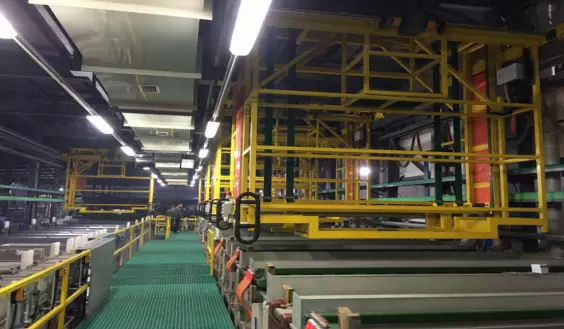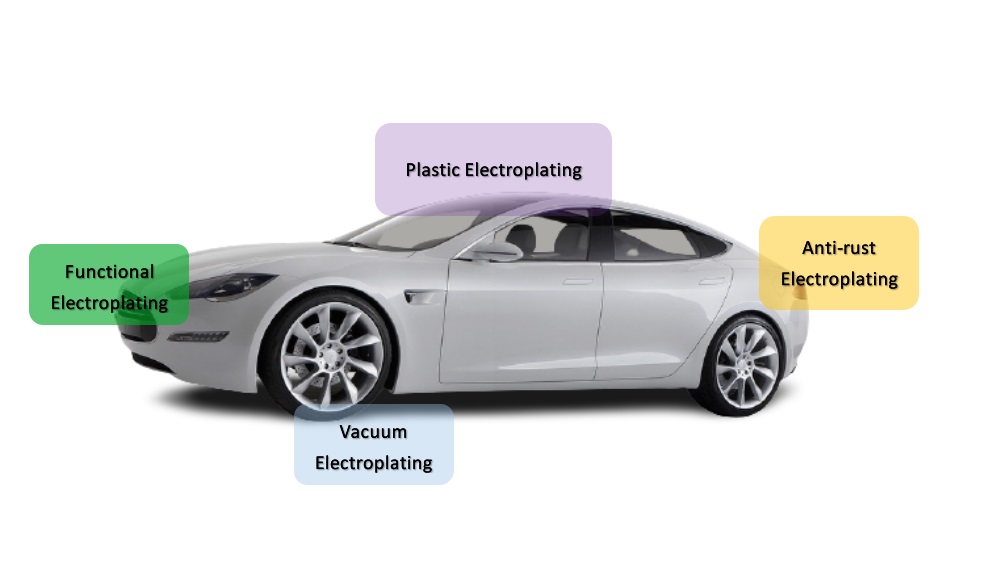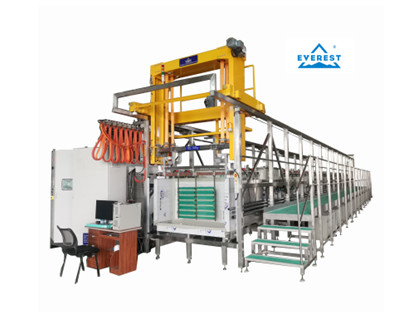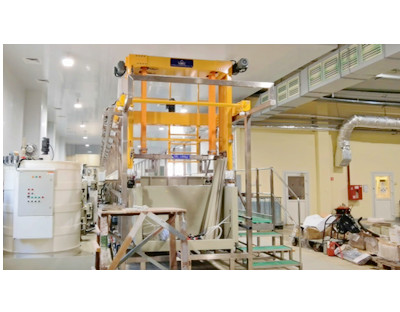I, Why the the brightness of chromium layer is poor and easy to burn?
|
Possible causes |
Cause analysis and treatment methods |
|
(1) Chromic acid content is too low |
See the cause analysis and treatment of fault phenomenon 2 (9) for details |
|
(2) Sulfuric acid content is too low |
See the cause analysis and treatment of fault phenomenon 2 (9) for details |
|
(3) Trivalent chromium content is too high |
See the cause analysis and treatment of fault phenomenon 2 (10) for details |
|
(4) Trivalent chromium content is too low |
See the cause analysis of fault phenomenon 2 (10) for details Treatment method 1: large area cathode electrolysis method. See the cause analysis of fault phenomenon 2 (10) in new Chrome plating Production method of cr3+ in liquid ① Treatment method 2: reductant method. See the cause of fault phenomenon 2 (10) for details Generation method of cr3+ in new chromium plating solution ② |
|
(5) Excessive foreign metal impurities |
See the cause analysis and treatment of fault phenomenon 2 (11) and fault phenomenon 2 (12) for details |
|
(6) The temperature is too low |
See the cause analysis of fault phenomenon L (5) for details Treatment method: raise the bath temperature to the standard value, and reasonably set the cathode current density |
|
(7) Cathode current density is too high |
See the cause analysis of fault phenomenon L (5) for details Treatment method: 1.Accurately measure the area of the plated workpiece, reasonably set the current value, and strictly control the bath temperature to the standard value; 2.Cathodic protection measures shall be taken when necessary |
|
(8) Poor anode conductivity |
See the cause analysis and treatment of fault phenomenon 2 (7) for details |
|
(9) There is a small amount of NO3 impurities in the plating solution |
See the cause analysis and treatment of fault phenomenon 2 (13) for details |
|
Possible causes |
Cause analysis and treatment methods |
II, There are obvious cracks on the chromium layer;
|
Possible causes |
Cause analysis and treatment methods |
|
(1) The temperature is too low and the cathode current density is too high |
See the cause analysis of fault phenomenon L (5) for details Treatment method: raise the bath temperature to the standard value and set the current value reasonably |
|
(2) Chromic acid content is too low or sulfuric acid content is too high |
See the cause analysis and treatment of fault phenomenon 2 (10) for details |
|
(3) Excessive chloride ion content |
See the cause analysis and treatment of fault phenomenon 1 (9) for details |
|
(4) The stress of bottom nickel is too large |
One of the reasons: Plate with nickel too much chloride ion in the liquid Treatment method: Analyze and adjust the bath composition to the standard value; Dilute the plating solution and adjust other components to the standard value For detailed discussion, please refer to the cause analysis and treatment method of fault phenomenon 3 (6) in Chapter 4 Cause analysis II: there is too much secondary brightener in the nickel plating solution. See the cause analysis and treatment method of fault phenomenon 1 (4) of fault phenomenon 6 in Chapter 4 for details Cause analysis No. 3: there are too many iron impurities in the nickel plating solution. See Chapter IV, cause analysis and treatment of fault phenomenon 1 (6) Cause analysis No. 4: there are too many organic impurities in the nickel plating solution. See the cause analysis and treatment methods of fault phenomenon I (3) in Chapter 4 for details |
|
(5) Chromium coating is too thick |
Treatment method: short electroplate time, reduce chromium layer thickness |
III,Chromium plating layer falls off;
|
Possible causes |
Cause analysis and treatment methods |
|
(1) Bottom nickel passivation |
See the cause analysis and treatment method of fault phenomenon 14 in Chapter IV for details |
|
(2) Chrome plating power failure in process |
See the cause analysis and treatment of fault phenomenon L (8) and fault phenomenon 6 (5) for details |
|
(3) Cathode current density is too high |
See cause analysis and treatment of fault phenomenon 3 (7) for details |
|
(4) Plate with nickel the surface of the layer is polluted by dirt |
After the nickel layer is polished, the workpiece after nickel plating or chromium removal is directly chrome plated. If the chromium layer is not removed cleanly, the activation is poor, or the polished workpiece is polluted by polishing paste, and the cleaning is not complete before entering the chromium plating bath to ensure the surface of the nickel layer is clean and activated, the chromium plating layer will fall off Treatment method: strengthen the pretreatment before chromium plating to ensure that the workpiece is clean and the nickel layer is fully activated |
|
(5) The hardness of chromium plating layer is too large |
Treatment method: reasonably set process parameters and select chromium plating process with slightly lower hardness |
|
Possible causes |
Cause analysis and treatment methods |
|
(1) Bottom nickel passivation |
See the cause analysis and treatment method of fault phenomenon 14 in Chapter IV for details |
IV, Chrome plated workpiece produces hanger shadow;
|
Possible causes |
Cause analysis and treatment methods |
|
(1) Hanging fixture shadow caused by acid plated copper layer |
See the cause analysis and treatment methods of fault phenomenon 3 and fault phenomenon 20 in Chapter III for details |
|
(2) Plate with nickel layer produces hanger shadow |
See the cause analysis and treatment method of fault phenomenon 13 in Chapter III for details |
|
(3) The contact point of the hook is too thick |
For details, please refer to the discussion on hangers in the cause analysis of fault phenomenon 6 (1) and (2) Treatment method: reasonably design and standardize the use of hangers, and strengthen the maintenance of hangers |








 Mar. 08, 2022
Mar. 08, 2022 




